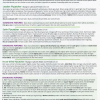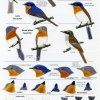Description
This guide gives far more identification information than the field guides offer.
Some modern field guides have become mini handbooks, often at the expense of identification details. Some are far too heavy to take into the field. There is a tendency to design them for advanced birders, professional ornithologists and twitchers rather than the average birder who is often unfamiliar with taxonomic order and complicated scientific jargon.
Another unhelpful trend is to include many vagrant birds from Australia’s far flung island territories, birds from Asia which overshoot on migration and which will never occur on the Australian mainland. This creates confusion and frustration for average birders who are forced to wade through so many non-Australian birds.
How often does one hear “I can’t find the bird in the field guide.”
The Identification Guide to the Difficult Small Birds of Australia

Companion Checklist
![]() Devoted entirely to identification of the small difficult species — the LBJs of the birding world
Devoted entirely to identification of the small difficult species — the LBJs of the birding world
![]() Much more identification information/detail than the field guides offer
Much more identification information/detail than the field guides offer
![]() Diagnostic features fully explained and illustrated
Diagnostic features fully explained and illustrated
![]() Contains only useful practical characteristics for field use
Contains only useful practical characteristics for field use
![]() Compares similar and difficult to identify small birds in the same area
Compares similar and difficult to identify small birds in the same area
![]() Very difficult groups such as the four yellow-spot honeyeaters
Very difficult groups such as the four yellow-spot honeyeaters
![]() Correct jizz — most birds in field guides are illustrated side on which is often unhelpful for identification
Correct jizz — most birds in field guides are illustrated side on which is often unhelpful for identification
![]() Easily carried in the field — less than 400 grams
Easily carried in the field — less than 400 grams






